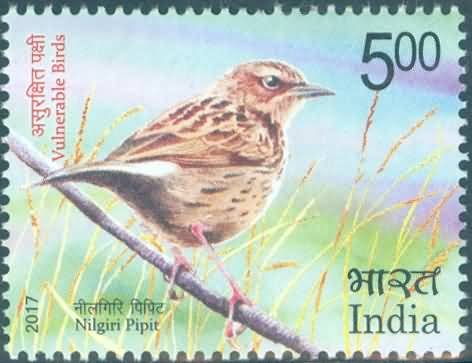Nilgiri Pipit (Anthus nilghiriensis)

Technical Data
| Stamp Set | Vulnerable Birds |
|---|---|
| Date of Issue | September 18, 2017 |
| Denomination | Rs. 5 |
| Quantity | 500,000 |
| Perforation | 13¼ x 13¾ |
| Printer | Security Printing Press, Hyderabad |
| Printing Process | Wet Offset |
| Watermark | No Watermark |
| Colors | Multicolor |
| Credit (Designed By) | Mr. Suresh Kumar Ms. Nenu Gupta |
| Catalog Codes |
Michel IN 3199A Yvert et Tellier IN 2890 Stanley Gibbons IN 3352 |
| Themes | Animals (Fauna) | Birds |
IUCN Status: Vulnerable (VU)
The Nilgiri Pipit is classified as Vulnerable on the IUCN Red List due to its highly restricted range and rapidly declining habitat. Species placed under this category are considered to be at a high risk of endangerment in the wild.
Habitat and Distribution
The Nilgiri Pipit is endemic to the Western Ghats of southern India, occurring mainly in the higher altitudes of Kerala, Tamil Nadu, and Karnataka. It is most commonly observed:
- Above 2,000 metres in grassy upland slopes
- Occasionally descending to 1,000 metres
- In habitats interspersed with bushes, small trees, and marshy grasslands near streams
Surveys between 2002–2004 recorded a sharp decline in sightings at earlier known sites, indicating a shrinking and fragmented population.
Physical Characteristics
A small, attractive bird, the Nilgiri Pipit displays distinct plumage features that aid identification:
- Broad-edged buff to whitish supercilium
- Darker buff ear-coverts with occasional dark spotting near the malar region
- Tawny-olive to warm grey-brown upperparts with a greenish-yellow tinge
- Strong blackish-brown streaking from crown to mantle and scapulars
- Underparts buff to pale buff, with dark streaks on the breast and flanks
- Dark brown tail and wing coverts with two visible wing bars
- Bill blackish, iris dark brown, and legs pale to yellowish pink
Behaviour and Ecology
The species is known to:
- Feed mainly on creeping grasses in valley areas
- Nest in slightly taller marshy grasses and sedges, favouring moist terrain near water bodies
Despite being locally common in suitable patches, the species remains vulnerable due to the limited extent of its habitat.
Threats to Survival
The Nilgiri Pipit’s natural grassland habitat is being increasingly lost or degraded due to:
- Conversion of native grasslands into tea, eucalyptus, and silver wattle plantations
- Spread of invasive plant species such as wattle and scotch broom
- Livestock grazing leading to habitat disturbance
- Frequent grassland fires, both natural and human-induced
These pressures have resulted in severe habitat fragmentation, putting the species at continued risk.
